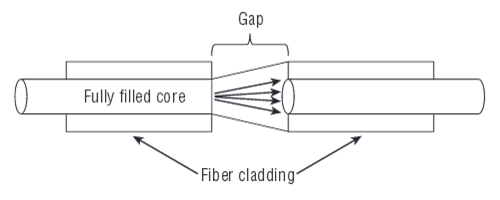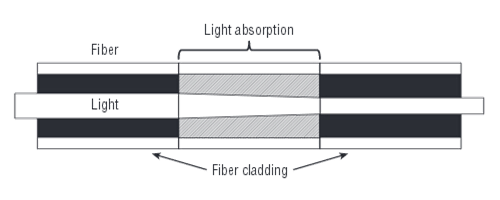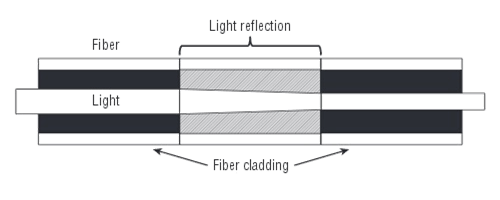What is Optical Attenuator?
Optical Attenuator (or fiber optic attenuator) is a passive device that is used to reduce the power level of an optical signal. The attenuator circuit allows a known source of power to be reduced by a predetermined factor, which is usually expressed as decibels (dB). Optical attenuators are generally used in single-mode long-haul applications to prevent optical overload at the receiver.
Principles of Optical Attenuators
Optical attenuators use several different principles in order to accomplish the desired power reduction. Attenuators may use the Gap-Loss, Absorptive, or Reflective technique to achieve the desired signal loss. The types of attenuators generally used are fixed, stepwise variable, and continuously variable.
Gap-Loss Principle
The principle of gap-loss is used in optical attenuators to reduce the optical power level by inserting the device in the fiber path using an in-line configuration. Gap-loss attenuators are used to prevent the saturation of the receiver and are placed close to the transmitter. They use a longitudinal gap between two optical fibers so that the optical signal passed from one optical fiber to another is attenuated. This principle allows the light from the transmitting optical fiber to spread out as it leaves the optical fiber. When the light gets to the receiving optical fiber, some of the light will be lost in the cladding because of gap and the spreading that has occurred. The gap-loss principle is shown in the figure below.

The gap-loss attenuator will only induce an accurate reduction of power when placed directly after the transmitter. These attenuators are very sensitive to modal distribution ahead of the transmitter, which is another reason for keeping the device close to the transmitter to keep the loss at the desired level. The farther away the gap-loss attenuator is placed from the transmitter, the less effective the attenuator is, and the desired loss will not be obtained. To attenuate a signal farther down the fiber path, an optical attenuator using absorptive or reflective techniques should be used. Note: The air gap will produce a Fresnel reflection, which could cause a problem for the transmitter.
Absorptive Principle
The absorptive principle, or absorption, accounts for a percentage of power loss in optical fiber. This loss is realized because of imperfections in the optical fiber that absorb optical energy and convert it to heat. This principle can be employed in the design of an optical attenuator to insert a known reduction of power.
The absorptive principle uses the material in the optical path to absorb optical energy. The principle is simple, but can be an effective way to reduce the power being transmitted and/or received. Here is the principle of the absorption of light.

Reflective Principle
The reflective principle, or scattering, accounts for the majority of power loss in optical fiber and again is due to imperfections in the optical fiber, which in this case cause the signal to scatter. The scattered light causes interference in the optical fiber, thereby reducing the amount of transmitted and/or received light. This principle can be employed in the planned attenuation of a signal. The material used in the attenuator is manufactured to reflect a known quantity of the signal, thus allowing only the desired portion of the signal to be propagated. This reflective principle is shown in the figure below.

Types of Optical Attenuators
>> According to the principles behind the attenuator theories, there are three types of optical attenuators: Fixed Attenuator, Stepwise Variable Attenuator, and Continuously Variable Attenuator.
Fixed Attenuator
Fixed Attenuators are designed to have an unchanging level of attenuation. They can theoretically be designed to provide any amount of attenuation that is desired. The output signal is attenuated relative to the input signal. Fixed attenuators are typically used for single-mode applications.
Stepwise Variable Attenuator
A stepwise variable attenuator is a device that changes the attenuation of the signal in known steps such as 0.1 dB, 0.5 dB, or 1 dB. These attenuators may be used in applications dealing with multiple optical power sources. For example, if there are three inputs available, there may be a need to attenuate the signal at a different level for each of the inputs. Conversely, they may also be used in situations where the input signal is steady, yet the output requirements change depending on the device that the signal is output to. Note: The stepwise variable attenuators should be used in applications where the inputs, outputs, and operational configurations are known.
Continuously Variable Attenuator
A continuously variable attenuator is an optical attenuator that can be changed on demand. It generally has a device in place that allows the attenuation of the signal to change as required. Continuously variable attenuators are used in uncontrolled environments where the input characteristics and/or output need continually change. This allows the operator to adjust the attenuators to accommodate the changes required quickly and precisely without any interruption to the circuit.
Note: Both the stepwise variable attenuator and continuously variable attenuator are collectively known as Variable Optical Attenuator (VOA). When people talk about the VOA attenuator, it generally means a continuously variable optical attenuator.
>>According to the different connector types, there are several types of optical attenuators: LC Attenuator, SC Attenuator, ST Attenuator, FC Attenuator, E2000 Attenuator etc., available in UPC/APC polish types.
Packaging of Optical Attenuators
Optical attenuators typically come in two forms of packaging: Bulkhead Attenuator and In-Line Attenuator. The bulkhead optical attenuators can be plugged into the receiver receptacle. The in-line optical attenuators resemble a fiber patch cord and is typically used between the patch panel and the receiver. Here are a 10 dB Fixed LC/UPC Bulkhead Optical Attenuator and a 0~60 dB LC/UPC to LC/UPC In-Line Variable Optical Attenuator
